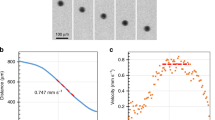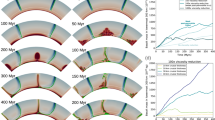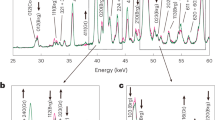Abstract
Subduction of oceanic lithosphere is the main process by which material from Earth’s surface and atmosphere is recycled back into the deep mantle. Seismic images indicate that subducting slabs of oceanic lithosphere can stagnate and broaden in the shallow lower mantle1,2. The main phases of the lower mantle, bridgmanite and ferropericlase, do not show any structural transitions at these depths, so only moderate and smooth viscosity variations are expected with depth3,4 to at least ∼2,500 km. The reason for slab stagnation, which may also lead to the formation of chemically distinct reservoirs in Earth’s deep mantle5, is therefore unclear. Here we use synchrotron radial X-ray diffraction to measure in situ the deformation behaviour of ferropericlase at pressures of up to 96 GPa. We find that the strength of ferropericlase increases by a factor of three at pressures from 20 to 65 GPa. Modelling based on our experimental data shows that the viscosity in the region surrounding the subducting slabs could increase by 2.3 orders of magnitude throughout the upper 900 km of the lower mantle. Such a strong increase in viscosity can lead to the stagnation of slabs that are sinking through the shallow lower mantle.
This is a preview of subscription content, access via your institution
Access options
Subscribe to this journal
Receive 12 print issues and online access
$259.00 per year
only $21.58 per issue
Buy this article
- Purchase on Springer Link
- Instant access to full article PDF
Prices may be subject to local taxes which are calculated during checkout



Similar content being viewed by others
References
Fukao, Y. & Obayashi, M. Subducted slabs stagnant above, penetrating through, and trapped below the 660 km discontinuity. J. Geophys. Res. 118, 5920–5938 (2013).
Li, C., van der Hilst, R. D., Engdahl, E. R. & Burdick, S. A new global model for P wave speed variations in Earth’s mantle. Geochem. Geophys. Geosys. 9, Q05018 (2008).
Yamazaki, D. & Karato, S-i. Some mineral physics constraints on the rheology and geothermal structure of Earth’s lower mantle. Am. Mineral. 86, 385–391 (2001).
Ammann, M. W., Brodholt, J. P., Wookey, J. & Dobson, D. P. First-principles constraints on diffusion in lower-mantle minerals and a weak D′′ layer. Nature 465, 462–465 (2010).
Hofmann, A. W. Mantle geochemistry: The message from oceanic volcanism. Nature 385, 219–229 (1997).
Van der Hilst, R. D., Widiyantoro, S. & Engdahl, E. R. Evidence for deep mantle circulation from global tomography. Nature 386, 578–584 (1997).
Grand, S. P. Mantle shear structure beneath the Americas and surrounding oceans. J. Geophys. Res. 99, 11591–11621 (1994).
Tackley, P. J. Mantle convection and plate tectonics: Toward an integrated physical and chemical theory. Science 288, 2002–2007 (2000).
Walter, M. J. et al. Deep mantle cycling of oceanic crust: Evidence from diamonds and their mineral inclusions. Science 334, 54–57 (2011).
Faccenda, M. Mid mantle seismic anisotropy around subduction zones. Phys. Earth Planet. Inter. 227, 1–19 (2014).
McNamara, A. K., van Keken, P. E. & Karato, S-I. Development of anisotropic structure in the Earth’s lower mantle by solid-state convection. Nature 416, 310–314 (2002).
Yamazaki, D., Yoshino, T., Matsuzaki, T., Katsura, T. & Yoneda, A. Texture of (Mg, Fe)SiO3 perovskite and ferro-periclase aggregate: Implications for rheology of the lower mantle. Phys. Earth Planet. Inter. 174, 138–144 (2009).
Takeda, Y-T. Flow in rocks modelled as multiphase continua: Application to polymineralic rocks. J. Struct. Geol. 20, 1569–1578 (1998).
Merkel, S. et al. Deformation of polycrystalline MgO at pressures of the lower mantle. J. Geophys. Res. 107(B11), 2271 (2002)
Lin, J-F. et al. Deformation of lower-mantle ferropericlase (Mg, Fe)O across the electronic spin transition. Phys. Chem. Miner. 36, 585–592 (2009).
Amodeo, J., Carrez, P. & Cordier, P. Modelling the effect of pressure on the critical shear stress of MgO single crystals. Philos. Mag. 92, 1523–1541 (2012).
Marquardt, H., Speziale, S., Reichmann, H. J., Frost, D. J. & Schilling, F. R. Single-crystal elasticity of (Mg0.9Fe0.1)O to 81 GPa. Earth Planet. Sci. Lett. 287, 345–352 (2009).
Tommaseo, C., Devine, J., Merkel, S., Speziale, S. & Wenk, H-R. Texture development and elastic stresses in magnesiowüstite at high pressure. Phys. Chem. Miner. 33, 84–97 (2006).
Miyagi, L. et al. Combined resistive and laser heating technique for in situ radial X-ray diffraction in the diamond anvil cell at high pressure and temperature. Rev. Sci. Instrum. 84, 025118–025119 (2013).
Marquardt, H. et al. Elastic shear anisotropy of ferropericlase in Earth’s lower mantle. Science 324, 224–226 (2009).
Cordier, P., Amodeo, J. & Carrez, P. Modelling the rheology of MgO under Earth’s mantle pressure, temperature and strain rates. Nature 481, 177–180 (2012).
Wentzcovitch, R. M. et al. Anomalous compressibility of ferropericlase throughout the iron spin cross-over. Proc. Natl Acad. Sci. USA 106, 8447–8452 (2009).
Morra, G. et al. The fate of the slabs interacting with a density/viscosity hill in the mid-mantle. Phys. Earth Planet. Inter. 180, 271–282 (2010).
Ribe, N. M., Stutzmann, E., Ren, Y. & van der Hilst, R. Buckling instabilities of subducted lithosphere beneath the transition zone. Earth Planet. Sci. Lett. 254, 173–179 (2007).
Van der Hilst, R. D. & Kárason, H. Compositional heterogeneity in the bottom 1000 kilometers of Earth’s mantle: Toward a hybrid convection model. Science 283, 1885–1888 (1999).
Becker, T. W. & Boschi, L. A comparison of tomographic and geodynamic mantle models. Geochem. Geophys. Geosyst. 3, 1003 (2002)
Houser, C. & Williams, Q. The relative wavelengths of fast and slow velocity anomalies in the lower mantle: Contrary to the expectations of dynamics? Phys. Earth Planet. Inter. 176, 187–197 (2009).
Cammarano, F., Marquardt, H., Speziale, S. & Tackley, P. J. Role of iron-spin transition in ferropericlase on seismic interpretation: A broad thermochemical transition in the mid mantle? Geophys. Res. Lett. 37, L03308 (2010).
Merkel, S. et al. Deformation of (Mg0.9Fe0.1)SiO3 Perovskite aggregates up to 32 GPa. Earth Planet. Sci. Lett. 209, 351–360 (2003).
Mitrovica, J. X. & Forte, A. M. A new inference of mantle viscosity based upon joint inversion of convection and glacial isostatic adjustment data. Earth Planet. Sci. Lett. 225, 177–189 (2004).
Acknowledgements
H.M. acknowledges support by the German Science Foundation through grants SP1216/3-1 and MA4534/3-1. L.M. was partially supported by the National Science Foundation grant EAR-1344579. The Advanced Light Source is supported by the Director, Office of Science, Office of Basic Energy Sciences, of the US Department of Energy under Contract No. DE-AC02-05CH11231. We thank D. Frost for providing the ferropericlase powders and K. K. M. Lee for providing consumables. Discussions with S. Merkel, S. Speziale, R. Myhill, R. Farla and L. Morales are acknowledged. We would also like to thank P. Cordier, whose comments greatly improved the manuscript.
Author information
Authors and Affiliations
Contributions
Both authors contributed equally to the design and execution of this research and wrote the paper.
Corresponding author
Ethics declarations
Competing interests
The authors declare no competing financial interests.
Supplementary information
Supplementary Information
Supplementary Information (PDF 1383 kb)
Rights and permissions
About this article
Cite this article
Marquardt, H., Miyagi, L. Slab stagnation in the shallow lower mantle linked to an increase in mantle viscosity. Nature Geosci 8, 311–314 (2015). https://doi.org/10.1038/ngeo2393
Received:
Accepted:
Published:
Issue Date:
DOI: https://doi.org/10.1038/ngeo2393
This article is cited by
-
Periclase deforms more slowly than bridgmanite under mantle conditions
Nature (2023)
-
Variation in bridgmanite grain size accounts for the mid-mantle viscosity jump
Nature (2023)
-
Weak cubic CaSiO3 perovskite in the Earth’s mantle
Nature (2022)
-
Small-Scale Heterogeneity and Seismic Anisotropy in the Mid-Mantle: Oceanic Crust versus Meta-Stable Olivine
Journal of Earth Science (2022)
-
A thin mantle transition zone beneath the equatorial Mid-Atlantic Ridge
Nature (2021)



